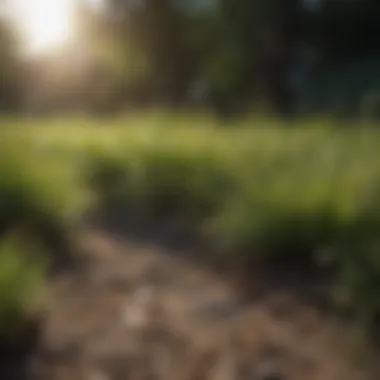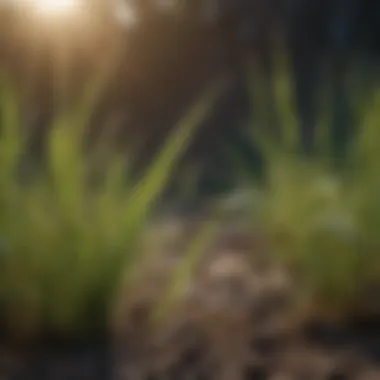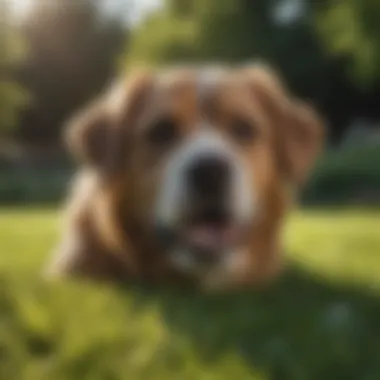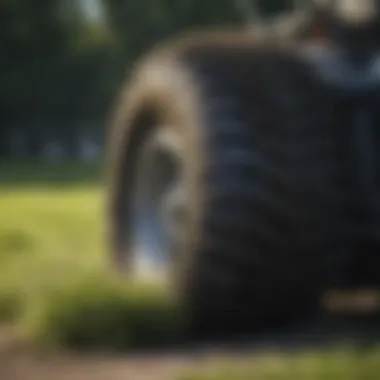Understanding Grass Burn Spots: Causes and Solutions


Intro
Grass burn spots can significantly affect the overall health and aesthetics of a lawn. Understanding their causes can prevent further damage and promote effective restoration. In this article, we will examine what leads to these discolorations, how to prevent them, and the best practices for recovery. This knowledge plans to equip homeowners and agronomists with strategies to nurture and maintain lush, healthy grass.
Topic Overview
Definition and Importance
Grass burn spots are localized areas of a lawn that lose their green hue, typically turning brown or yellow. The significance of understanding these spots lies in their potential impact on the lawn’s appearance and vitality. Recognizing their causes helps in developing appropriate strategies for prevention and treatment. Maintaining a healthy lawn is not only aesthetically pleasing but also essential for soil health and biodiversity.
Brief History and Evolution
The phenomenon of grass burn spots has been acknowledged for centuries, often attributed to specific causes. In ancient times, they were primarily related to environmental conditions and animal activity. However, with advancements in agricultural practices and chemistry, more causes have been identified such as chemical fertilization and herbicides. A deeper understanding has evolved, focusing on sustainable lawn care approaches that balance aesthetics with ecological integrity.
Causes of Grass Burn Spots
There are various factors leading to the formation of grass burn spots, including:
- Environmental Factors: Extreme weather, drought, or waterlogging can stress grass.
- Pet Damage: Animal urine can create spots due to high nitrogen levels.
- Chemical Treatments: Fertilizers or pesticides may have adverse effects if misapplied.
Understanding these causes allows for targeted interventions, which is crucial for lawn health.
Prevention Strategies
Employing preventive measures is vital for minimizing the appearance of burn spots. Here are some strategies:
- Proper Watering: Ensure even moisture without over-saturation.
- Soil Testing: Conduct tests to understand nutrient levels and pH.
- Step-Lawn Fertilizer: Use balanced fertilizers that match the lawn’s needs.
Taking these actions helps create resilient grass that can better withstand stressors.
Restoration Techniques
If burn spots do appear, recovery techniques can help restore the lawn:
- Reseeding: Plant grass seed in affected areas to encourage regrowth.
- Soil Aeration: Loosen the soil to promote better root growth and nutrient absorption.
- Fertilization: Apply a slow-release fertilizer to support healing grass.
"A proactive lawn care approach not only beautifies but sustains the ecosystem."
These practices, when applied systematically, can revive a damaged lawn and promote its overall health.
The End
Understanding grass burn spots and their management is essential for anyone interested in lawn care, be it a newbie gardener or a seasoned professional. By recognizing the causes, implementing prevention strategies, and utilizing effective restoration techniques, one can maintain a vibrant lawn that thrives amidst challenges.
Preface to Grass Burn Spots
Understanding grass burn spots is crucial for anyone invested in the health and aesthetics of their lawns. These spots, which often appear unsightly, can be indicative of underlying issues that, if left unaddressed, may lead to more significant lawn deterioration. A lawn that is healthy not only adds beauty to a property but also plays a vital role in the local ecosystem.
The presence of grass burn spots can stem from various causes, including environmental stressors, improper lawn care practices, and even pet-related damage. Recognizing the root causes enables homeowners and landscapers to apply appropriate preventive measures and restoration techniques.
Moreover, comprehending the nature of grass burn spots helps in fostering a proactive approach to lawn management. This proactive stance is beneficial not just in mitigating current issues but also in preventing future occurrences. For instance, understanding how specific grass types react to stressors can guide the choice of plants that will thrive in a given environment.
Awareness of these factors fosters responsible gardening practices. Homeowners can tailor their lawn care strategies to suit the needs of their specific environment and lawn type. This knowledge aids in maintaining not only the visual appeal but also the overall health of the lawn, leading to a more sustainable outdoor space for enjoyment and biodiversity.
Investing time to understand the factors surrounding grass burn spots is a necessary step toward creating and sustaining a healthy lawn.
Identifying Grass Burn Spots
Understanding how to identify grass burn spots is crucial for maintaining a healthy lawn. Recognizing these issues early helps in timely intervention, preventing further damage and ensuring the grass can thrive. Gardeners and homeowners benefit from knowing the signs of burn spots, as this knowledge promotes proper care and facilitates healthy soil management. Moreover, understanding visual cues allows for effective communication when seeking professional advice or referring issues on online platforms such as Reddit.
Visual Characteristics


The visual characteristics of grass burn spots play a significant role in determining the type of treatment required. Typically, burn spots manifest as areas of discoloration compared to the surrounding grass. They can appear faded or yellowed, often with dry patches. Sometimes, the affected grass may start to wilt, leaving a crispy texture underfoot. Early detection is key. Homeowners should regularly inspect their lawns to monitor changes in appearance.
"Regular inspection is key to early detection of grass burn spots, enabling effective recovery methods."
Some common characteristics of burn spots include:
- Irregular Shapes: These may vary from circular to patchy, influenced by the cause of the burn.
- Border Contrast: A burn spot may contrast significantly in color with the healthy grass around it.
- Texture Variations: The healthy grass might feel lush while the burn spots exhibit dryness or brittleness.
Maintaining close observation will help in recognizing such characteristics and can lead to effective management strategies.
Specific Colors and Patterns
Grass burn spots can also exhibit specific colors and patterns, providing further clues about their underlying causes. The hue can vary based on factors such as temperature, moisture levels, and type of grass.
For instance, brown or yellow spots often indicate stress due to a lack of moisture or potential chemical damage. On the other hand, white or bleached areas can signal severe burns caused by concentrated chemical treatments or excessive foot traffic. Patterns can also help identify the source; clustered spots may suggest pet damage, while uniformly spread discoloration may highlight a systemic issue such as soil nutrient deficiency.
In summary, being aware of specific colors and patterns in grass burn spots can lead to better diagnosis and prevention strategies. This understanding is vital for implementing the right treatment approach, ensuring the lawn retains its vigor and appeal.
Common Causes of Grass Burn Spots
Understanding the common causes of grass burn spots is crucial for anyone interested in maintaining a healthy lawn. Identifying these causes allows homeowners and agricultural enthusiasts to take effective measures in preventing future occurrences. The prevalence of burn spots can lead to decreased aesthetic appeal and may even indicate underlying issues affecting the grass's overall health. Each factor contributing to burn spots has distinct characteristics and implications, making it essential to grasp their specifics.
Chemical Treatments
Chemical treatments can significantly impact grass health. Herbicides, pesticides, and fungicides, when misapplied or over-applied, can result in grass burn spots. For instance, high concentrations of glyphosate can cause severe grass discoloration or even death. It is vital to follow manufacturer instructions meticulously and consider the type of grass before application. Homeowners often overlook these details, which can lead to unsightly damage. Using alternatives that are safer for lawns, such as organic treatments, can mitigate this risk.
Environmental Stressors
Environmental stress plays a significant role in creating burn spots on lawns. Factors such as extreme temperatures—both heat and cold—drought conditions, and improper soil conditions can increase the grass's vulnerability. Stress can weaken grass, making it less resilient to foot traffic, pests, and diseases. Understanding the environmental conditions prevalent in a specific area can inform effective lawn care strategies. For example, during a hot summer, it is prudent to water more frequently to help the grass cope with temperature extremes.
Pet Urine and Feces
Pet urine is a common cause of grass burn spots, primarily due to the concentration of nitrogen that can “burn” the grass. This occurs when the dog or cat marks its territory, resulting in localized yellow or brown spots. Management strategies may include training pets to eliminate in designated areas, or using products designed to help neutralize the effects of pet waste. Regular rinsing of affected areas with water can also help mitigate the damage.
Nutrient Imbalances
Nutrient imbalances affect grass health dramatically. Both deficiencies and excesses of nitrogen, potassium, and phosphorus can lead to burn spots. For instance, over-fertilization often results in rapid growth, which may leave grass prone to burn during drought conditions. Regular soil testing helps in identifying nutrient levels and enables appropriate amendments to be made accordingly. Implementing a balanced fertilization schedule tailored to the grass type can promote healthier growth.
Fungal Infections
Fungal infections can cause grass burn spots, particularly in warm and humid conditions. Diseases like dollar spot and brown patch can create distinct patterns in the lawn, manifesting as discolored patches. Prompt identification and treatment with fungicides or cultural practices can alleviate the damage. Moreover, preventing fungal growth involves managing lawn moisture levels and ensuring proper air circulation. This not only helps in recovery but also maintains the overall integrity of the grass.
"Understanding the root causes of grass burn spots is essential for effective lawn management."
In summary, recognizing and addressing the common causes of grass burn spots is fundamental for maintaining a vibrant lawn. Each factor interplays with others, suggesting that integrated management approaches are often effective. By doing so, one can preserve the aesthetics and health of the grass over time.
Preventive Measures for Grass Burn Spots
Preventing grass burn spots is essential for maintaining a healthy and aesthetically pleasing lawn. By understanding and implementing effective strategies, homeowners can mitigate the risk of these unsightly discolorations. This section focuses on key elements that contribute to lawn health, the benefits of proactive care, and considerations to keep in mind.
Proper Lawn Care Practices
Taking care of your lawn involves more than just mowing. Regular maintenance is crucial. This includes aeration, which improves air circulation and nutrient absorption in the soil. Aeration can help alleviate compacted soil that may contribute to poor grass health. Additionally, maintaining a proper mowing height is important. Cutting grass too short can stress the plants and lead to burn spots. Aim to keep the grass at a height that suits its type and encourages growth.
Furthermore, regular dethatching can remove excessive organic matter, allowing your lawn to breathe better. This simple practice can significantly enhance the overall health of your grass. Keeping up with these proper lawn care practices not only prevents burn spots but also enhances the lawn’s vigor and resilience against drought and disease.
Understanding Soil Health
Soil health is foundational to a resilient lawn. Healthy soil promotes strong root systems and helps grass resist stressors that cause burn spots. Regular soil testing provides insights into pH and nutrient levels. Addressing deficiencies can make a substantial difference. For instance, low nitrogen levels can lead to yellowing and weak growth.
Incorporating organic matter, such as compost, can enhance soil structure and nutrient content. A rich microbiome helps facilitate essential nutrient uptake. Cultivating a deep understanding of soil health is key to ensuring that your lawn thrives, reducing the occurrence of burn spots effectively.


Choosing Safe Chemical Alternatives
While chemicals may provide quick results in lawn care, choosing alternatives is often safer for both grass and the environment. Natural fertilizers, like bone meal or fish emulsion, promote healthy growth without the risk of chemical burn. Using herbicides and pesticides that are specifically formulated to be lawn-friendly can also minimize potential harm. Always adhere to the manufacturer’s instructions.
Additionally, integrating integrated pest management (IPM) techniques can help control pests and diseases with minimal chemical input. By emphasizing safe chemical alternatives, you not only protect your lawn but also contribute to a healthier ecosystem.
Watering Techniques
Watering is a fundamental aspect of lawn care that directly affects grass health. Proper watering techniques can prevent burn spots caused by over or under-watering. A general guideline is to water deeply but infrequently. This encourages deeper root growth and helps the lawn become more drought-resistant.
Timing also matters; watering in the early morning can reduce evaporation losses and fungal diseases. It also allows grass to absorb moisture efficiently before the heat of the day. Developing a consistent watering schedule tailored to your local climate and grass type is essential for your lawn’s vitality.
Effective lawn care not only prevents burn spots but also enhances the overall beauty and health of your outdoor space.
By implementing these preventive measures, homeowners can significantly reduce the risk of grass burn spots. A well-maintained lawn stands as a testament to patience and knowledge, fostering a lush green space for enjoyment.
Treatment Options for Existing Grass Burn Spots
Addressing grass burn spots effectively contributes significantly to the overall health and appearance of a lawn. Recognizing appropriate treatment options becomes crucial for homeowners looking to restore their grass to its former glory. Implementing these measures not only mitigates damage but also promotes long-term vitality. This section highlights several effective approaches aimed at treating existing burn spots, elucidating their respective advantages, considerations, and proper applications.
Natural Recovery Techniques
One of the simplest methods to treat grass burn spots is allowing for natural recovery. Grass has a remarkable ability to heal itself when given the right conditions. The key here is to identify the burn spots early and minimize stress factors.
To enhance natural recovery, consider the following strategies:
- Reduce foot traffic on affected areas. This aids in allowing the grass to recover without further compaction.
- Adjust watering schedules. Ensure that the grass receives adequate moisture, especially during dry spells.
- Provide shade, if possible, to limit sun exposure which may exacerbate damage.
Implementing these steps allows grass to regenerate in its own time, often leading to better recovery without unnatural interventions.
Use of Lawn Repair Products
For those seeking more immediate results, lawn repair products can be effective. These specialized treatments often include a mixture of seeds, fertilizers, and mulch specifically designed to promote rapid growth in areas affected by burn spots.
Key factors to consider when using lawn repair products include:
- Soil Preparation: Ensure that the soil in the affected area is loose and aerated to facilitate seed germination.
- Choose High-Quality Products: Look for reputable brands that provide products tailored for recovery of damaged lawns.
- Follow Instructions: Adhere to application guidelines carefully. Over-application can lead to additional problems, including chemical burns.
Products like Scotts Turf Builder Lawn Repair can significantly improve recovery outcomes when applied correctly.
Overseeding as a Strategy
Overseeding is a strategic approach where new grass seed is sown over existing turf. This technique proves beneficial especially for treating burn spots. By introducing new varieties that withstand stress, overseeding promotes a denser and healthier lawn.
Considerations for overseeding include:
- Timing: The best time to overseed depends on grass type. For cool-season grasses, early fall is ideal. For warm-season types, early spring works best.
- Seed Selection: Choose seed varieties that match your current grass type, as well as those that are more resilient to heat or drought.
- Maintenance: After overseeding, ensure that the area receives regular watering and avoid heavy foot traffic until new grass is established.
The Role of Grass Types in Burn Spot Susceptibility
The susceptibility of grass to burn spots is largely influenced by the specific types of grass grown in a lawn. Different grass species have distinct biological and physiological characteristics that determine their resilience or vulnerability to environmental stressors, chemical applications, and other potentially damaging factors. Understanding how various grass types respond to these influences is crucial for effective lawn management and for minimizing the occurrence of burn spots.
Choosing the appropriate grass type for a particular region or environment can prevent the conditions that lead to burn spots. Homeowners and horticulturists alike benefit from this knowledge, as it allows for more informed decisions about lawn care.
Cool-Season Grasses
Cool-season grasses, such as Kentucky Bluegrass, Perennial Ryegrass, and Tall Fescue, thrive in areas with cooler temperatures and are most vigorous during the spring and fall. These grasses typically require more moisture and can be prone to stress during hot summer months.
One of the challenges with cool-season grasses is their sensitivity to heat and drought. When exposed to high temperatures, these grasses can suffer from water deficiency, leading to discoloration and burn spots. Lawns with a predominance of cool-season grasses may need irrigation to maintain moisture during warm periods. Additionally, the use of heavy chemical treatments can further stress these grass types if they are already experiencing environmental pressures.
Warm-Season Grasses


Warm-season grasses, including Bermudagrass, Zoysiagrass, and Buffalograss, prefer a warmer climate and typically grow best in the summer. They have a deeper root system, which often gives them an advantage in heat and drought resilience.
However, warm-season grasses can also show susceptibility to burn spots due to high nitrogen levels, particularly when fertilized excessively. During periods of intense heat, these grasses may experience stress and become brown or patchy if not monitored carefully. Moreover, improper watering techniques can exacerbate the issue, leading to uneven moisture distribution which can create burn spots.
Long-Term Lawn Management Strategies
Long-term lawn management is crucial for maintaining a healthy and vibrant lawn, especially in the context of managing grass burn spots. Effective management strategies not only help to prevent burn spots from developing but also promote overall lawn resilience and sustainability. Several specific elements need to be considered when developing a long-term management plan.
Regular Soil Testing
Regular soil testing is essential for understanding the health of the lawn. It helps gardeners and farmers determine the pH level, nutrient content, and any potential deficiencies in the soil. By knowing the soil’s condition, one can make informed decisions about fertilization and amendment needs. For example, if a soil test reveals low nitrogen levels, applying a nitrogen-rich fertilizer can improve grass health and mitigate the risk of burn spots.
"Soil testing acts as a diagnostic tool; only through understanding the soil can one effectively manage and nurture the lawn."
Integrated Pest Management Approaches
Integrated Pest Management (IPM) approaches are significant for long-term lawn maintenance. This method combines biological, cultural, physical, and chemical tools in a way that minimizes economic, health, and environmental risks. By monitoring pest populations and applying control measures only when necessary, you can reduce the pesticide application that might harm beneficial organisms in the soil. Implementing IPM effectively helps in maintaining a healthier lawn ecosystem and reduces the likelihood of pest-induced stress leading to burn spots.
Fertilization Best Practices
Applying fertilizers in a well-planned manner is a critical aspect of long-term lawn management. It is important to choose the right type of fertilizer based on soil tests and grass variety. Over-fertilization is a common cause of grass burn spots, as excessive nitrogen can lead to rapid growth that the lawn cannot support, especially in dry conditions. Utilizing slow-release fertilizers can help provide nutrients gradually, reducing the risk of burn and promoting healthier grass development. Regularly reviewing fertilization schedules based on seasonal changes further ensures that the turf remains nourished throughout the year.
The Importance of Monitoring Lawn Health
Monitoring lawn health is vital for maintaining the overall appearance and vitality of grass. Regular observation helps identify any emerging issues, such as burn spots, before they escalate into more severe problems. By keeping a close watch, homeowners and agronomists can take proactive measures, ensuring that the lawn remains lush and vibrant throughout the seasons.
There are several specific elements involved in monitoring lawn health:
- Soil Quality: Assessing soil conditions is essential. Soil tests can gauge pH levels and nutrient content, informing necessary adjustments that can prevent imbalances leading to burn spots.
- Watering Practices: Evaluating watering frequency and amount helps. Overwatering or underwatering can cause stress to the grass, making it more susceptible to damage.
- Pest Activity: Regular check-ups for pests or disease signs support early intervention. Identifying pest infestations can lead to effective treatment, safeguarding grass health.
Benefits of consistent monitoring include:
- Early Detection: Spotting problems in their infancy allows for targeted interventions.
- Improved Aesthetics: A well-maintained lawn enhances the property’s value. Healthy grass projects care and attention.
- Resource Conservation: Preventing severe damage reduces the need for extensive restoration, thus saving time and resources in the long run.
"Regular monitoring creates an opportunity for improvement before any costly damage occurs."
When monitoring lawn health, consider practical strategies, such as checking for uniform growth patterns and testing for moisture levels. Engaging with local resources, like agricultural extension offices, can also provide valuable insights tailored to your specific region.
Seasonal Checklists
Creating seasonal checklists simplifies the lawn monitoring process. Each season presents unique challenges and opportunities for grass care. Consider the following components to include:
- Spring: Check for pest activity. Apply pre-emergent herbicides if necessary. Assess soil nutrient levels and start watering as the grass green up.
- Summer: Monitor for heat stress and adjust watering schedules accordingly. Inspect for signs of fungal infections due to humidity.
- Autumn: Conduct soil tests and apply fertilizers for winter health. Overseed if needed to ensure thickness and prevent winter burn.
- Winter: Inspect for physical damage from snow or ice. Plan for the upcoming spring maintenance strategies.
Signs of Stress and Recovery
Recognizing signs of stress is essential for timely interventions. Symptoms may include:
- Discoloration: Yellow or brown patches indicate stress from environmental factors or nutrient deficiencies.
- Wilting: Dry or shriveled grass blades suggest moisture issues.
- Reduced Growth: Slow growth or thinning indicates potential health challenges.
On the other hand, signs of recovery include:
- Lush Green Growth: New shoots indicate that the lawn is bouncing back.
- Stable Color: Even coloration across the lawn shows renewed health, suggesting successful intervention strategies.
By being vigilant about these markers, homeowners can effectively manage their lawns, creating a healthy environment for grass to thrive.
The End and Final Thoughts
Understanding grass burn spots is essential for anyone interested in maintaining a healthy lawn. This article has explored the various causes behind these unsightly discolorations, providing readers with a well-rounded view of the topic. Identifying the reasons for grass burn spots, such as chemical treatments, environmental stressors, and pet damage, is the first step towards effective prevention and restoration.
The significance of proper lawn care cannot be overstated. Implementing appropriate preventive measures, like regular soil testing and safe watering techniques, is crucial. These practices help reduce the risk of burn spots and enhance overall lawn health. Monitoring lawn conditions regularly also allows homeowners to spot early signs of stress before they escalate into larger issues.
Moreover, understanding the specific requirements of different grass types enhances long-term management strategies. Cool-season and warm-season grasses exhibit varying levels of susceptibility to burn spots, making it vital for the gardener to adapt their care for these distinctions.
Restoration techniques are necessary when grass burn spots do occur. Utilizing natural recovery methods, alongside commercial lawn repair products, can significantly promote the recovery of affected areas. Adopting overseeding strategies can also bolster grass resilience, ensuring a vibrant and robust lawn.
In summary, the attention given to grass burn spots reflects a commitment to lawn health. This article has aimed to equip readers with comprehensive insights that will enable effective management of burn spots, strengthening the beauty and vitality of their lawns. Remember that maintaining a lush lawn requires ongoing effort and understanding.
"Regular monitoring, appropriate care, and timely actions can transform lawn problems into opportunities for improvement."



